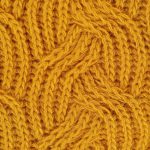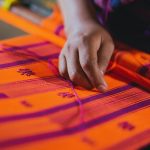If you're looking to elevate your home decor, using fabric markers can be an effective and creative way to personalize your textiles. You'll want to start by selecting high-quality markers that provide vibrant, long-lasting colors. Preparing your fabric is crucial, so make sure to wash and iron it for optimal results. Once you have your supplies ready, planning your design will help streamline the process. But before you jump into techniques like color blending, consider a few key tips to ensure your project turns out as envisioned. Let's explore those strategies next.
Table of Contents
Key Takeaways
- Choose vibrant, permanent fabric markers with various tip types for precise and bold designs.
- Prepare your fabric by washing, ironing, and securing it flat for optimal application.
- Use techniques like wet-on-wet blending and layering colors for depth in your designs.
- Transfer designs using methods like lightbox tracing, carbon paper, or stencils for accuracy.
Choosing the Right Fabric Markers
When it comes to choosing the right fabric markers for your home decor projects, you'll want to consider factors like color vibrancy, permanence, and tip type.
First, think about color vibrancy. You want markers that provide rich, bold colors to make your designs stand out. Look for brands that offer a wide range of hues, allowing you to mix and match for a unique look.
Next, consider permanence. You don't want your artwork to fade after a few washes. Check if the markers are washable and permanent once set, ensuring your designs last over time. Some markers require heat setting, while others don't, so read the instructions carefully.
Preparing Your Fabric Surface
To ensure your fabric is ready for decorating, start by washing and drying it to remove any sizing or residues that could interfere with the ink.
Use a mild detergent and avoid fabric softeners, as they can leave a coating that hinders ink absorption. After washing, dry the fabric completely, either in a dryer or by air-drying, depending on the material.
Next, iron the fabric if it's wrinkled. Smooth surfaces make it easier to apply your designs accurately. Make sure to use an appropriate heat setting for the specific type of fabric you're working with. If you're working with delicate materials, consider placing a thin cloth between the iron and the fabric to protect it.
Before you start decorating, lay your fabric on a flat, clean surface. You might want to use cardboard or a piece of plastic underneath to prevent bleed-through.
If you're working on a larger piece, securing the fabric with tape can help keep it in place. This preparation ensures that your fabric is both clean and ready, allowing your creativity to shine when you start using those fabric markers!
Basic Techniques for Application
Using fabric markers effectively requires a few basic techniques that can elevate your designs and ensure long-lasting results.
First, always start with a clean and dry fabric surface. This prevents any dirt or moisture from interfering with the ink's adhesion.
Next, plan your design on paper before applying it to the fabric. Sketching it out helps you visualize the final product and reduces mistakes.
When you're ready to apply the marker, use steady, even strokes. This technique avoids blotting and creates clean lines. If you're filling in areas, work in sections and don't rush—allow the ink to dry before moving on to adjacent sections to prevent smudging.
For intricate details, use the fine-tip markers for precision. If you need broader coverage, switch to the chisel-tip. Remember, you can achieve different effects by varying the pressure you apply; light pressure gives a softer look, while firm pressure results in bolder lines.
Finally, don't forget to allow your finished design to cure according to the manufacturer's instructions to ensure durability and washability.
Following these techniques will set a solid foundation for your fabric marker projects.
Color Blending and Layering
When you're working with fabric markers, mastering color blending can take your designs to the next level.
By layering colors, you can create stunning depth effects that make your home decor truly pop.
Let's explore some effective techniques to enhance your artwork with these methods.
Techniques for Blending Colors
Blending colors with fabric markers creates depth and dimension in your home decor projects, enhancing their visual appeal. To achieve seamless blends, you'll want to practice a few techniques. Start by choosing two or more colors that complement each other. Apply one color in a small area, then immediately use a clean brush or your finger to mix in the second color while it's still wet. This technique allows the colors to merge smoothly.
Another method is to use a stippling technique. By dabbing your fabric marker in varying intensities, you can create a gradient effect. It's great for backgrounds or creating texture.
Here's a quick reference table for blending techniques:
| Technique | Description | Best For |
|---|---|---|
| Wet-on-Wet | Blend colors while still wet | Smooth gradients |
| Stippling | Dab colors for a textured look | Backgrounds and shading |
| Layered Application | Build colors gradually for depth | Detailed designs |
| Feathering | Use a light touch to soften edges | Blending outlines |
Experiment with these techniques to find what works best for your style!
Layering for Depth Effects
Layering colors effectively adds richness and dimension to your fabric art, making your home decor truly stand out. By strategically applying different colors, you can create stunning depth effects that captivate the eye. Here's how to master layering with fabric markers:
Start with a Base Layer: Choose your primary color and apply it evenly to create a solid foundation.
Add Secondary Colors: Once the base is dry, introduce secondary colors. Use lighter shades to enhance highlights and darker shades for shadows.
Use a Stippling Technique: Dabbing your markers can create texture and depth, giving your piece a more dynamic appearance.
Blend for Gradients: If you want smooth transitions, lightly blend colors while they're still wet. This adds a soft, gradual effect.
Finish with Detail Work: Once your layers are dry, use fine-tipped markers for intricate details, enhancing the overall design.
Experimenting with these layering techniques will elevate your fabric art, transforming ordinary pieces into extraordinary decor that reflects your personal style.
Designing Custom Patterns
When designing custom patterns, you'll want to start by choosing your design style that reflects your personality.
Next, sketch your ideas to visualize how they'll look on fabric.
Choosing Your Design Style
Selecting a design style for your fabric markers can transform your home decor into a personalized masterpiece. The right design can reflect your personality and elevate your space. Here's how to choose a style that speaks to you:
- Bohemian: Embrace vibrant colors and intricate patterns for an eclectic vibe.
- Minimalist: Opt for simple lines and muted tones to create a calm, modern space.
- Vintage: Draw inspiration from classic designs, using floral motifs or retro colors.
- Geometric: Use bold shapes and contrasting colors to make a striking statement.
Consider the overall theme of your home and what makes you feel most comfortable. Look around your space and identify colors and textures that resonate with you.
Once you've settled on a style, think about how you can adapt it to various items, such as cushions, tablecloths, or wall hangings. Your chosen design will guide your creativity and ensure that each piece you create enhances your home's unique character.
Sketching Your Ideas
Before diving into your fabric marker projects, sketching your ideas can help you visualize custom patterns that perfectly capture your chosen design style. Grab a sketchbook and some pencils, and start brainstorming. Don't worry about perfection—this is just a space to explore your creativity.
Begin by outlining the shapes or motifs you envision. It could be florals, geometric patterns, or abstract designs. Play around with different arrangements, sizes, and orientations to see what feels right.
Once you have a few concepts, consider color schemes that align with your home decor. This can breathe life into your sketches and give you a clearer idea of the final look.
Don't hesitate to mix and match elements from various sketches. Sometimes the best designs come from combining different ideas into one cohesive pattern. Remember, this process is about experimentation, so let your imagination flow.
Once you've refined your sketches, you'll feel more confident when it's time to bring those designs to life with your fabric markers. You'll have a clear roadmap to follow, ensuring your final creations reflect your unique style beautifully.
Transferring Patterns to Fabric
Transferring your carefully crafted sketches onto fabric is an exciting step that brings your custom patterns to life. You can use various techniques to make this process smooth and effective. Here are some methods to consider:
- Lightbox Method: Place your fabric over a lightbox with your sketch underneath. This allows you to trace your design directly onto the fabric.
- Carbon Paper: Lay carbon paper between your sketch and fabric. Trace over the design to transfer it onto the fabric.
- Freehand Drawing: If you're confident, you can freehand your design directly onto the fabric using your fabric markers.
- Stencils: Create or buy stencils of your designs. Place them on the fabric and fill in with your markers for a clean look.
Whichever method you choose, ensure your fabric is clean and prepped for the best results.
This way, you'll be ready to fill in your patterns with vibrant colors, adding a personal touch to your home decor.
Happy crafting!
Setting and Caring for Your Artwork
How can you best display and maintain your fabric marker artwork to ensure it remains vibrant and beautiful over time?
Start by setting your artwork in a location that's away from direct sunlight. Sunlight can fade colors, so choose a well-lit area that keeps your piece protected. If you're framing your artwork, use UV-protective glass to minimize exposure to harmful rays.
When it comes to caring for your fabric masterpieces, hand wash them gently in cold water with mild detergent. Avoid harsh chemicals and bleach, which can damage the colors. If you need to iron your artwork, do it on the reverse side using a low heat setting to prevent smudging.
For items like pillows or tote bags, spot clean them as needed. Store any fabric pieces flat or rolled up to avoid creasing.
Lastly, always check the manufacturer's recommendations on your fabric markers for specific care instructions.
Inspiring Project Ideas
With your fabric marker artwork safely displayed and well cared for, you can now explore inspiring project ideas that bring even more creativity into your home decor. These projects let you showcase your personal style while enhancing your living space. Here are some fun ideas to spark your imagination:
- Custom Pillows: Transform plain throw pillows by adding unique designs or quotes that resonate with you.
- Artistic Tablecloths: Use fabric markers to create a stunning tablecloth that reflects your theme for gatherings or special occasions.
- Personalized Tote Bags: Make your own stylish tote bags by doodling or writing fun messages that express your personality.
- Decorative Curtains: Elevate your window treatments by drawing intricate patterns or bold graphics directly onto plain curtains.
Frequently Asked Questions
Can Fabric Markers Be Used on All Types of Fabric?
You can use fabric markers on many types of fabric, but it's best to check the marker's instructions. Natural fibers like cotton and linen work well, while synthetic fabrics might not hold the ink as effectively.
How Long Do Fabric Markers Typically Last on Fabric?
Fabric markers typically last several years on fabric, especially if you follow care instructions. They'll fade over time with washing and sun exposure, but storing items properly can help maintain their vibrancy longer.
Are Fabric Markers Safe for Children's Projects?
Yes, fabric markers are generally safe for children's projects, especially non-toxic options. Always check the label for safety information and let your kids unleash their creativity while ensuring they're using appropriate materials for their age.
Can I Wash Fabric Decorated With Markers?
Yes, you can wash fabric decorated with markers, but it's best to wait 24-72 hours after decorating. Use cold water and a gentle cycle to preserve your artwork. Always follow the marker's specific care instructions.
Do Fabric Markers Require Special Storage to Maintain Quality?
Yes, fabric markers do require special storage to maintain quality. Keep them upright in a cool, dry place, away from direct sunlight. This helps prevent the ink from drying out and ensures longevity for your markers.
- How Does Ring Spun Cotton Affect Garment Fit and Shape Retention? - August 13, 2024
- What Are the Challenges in Producing Ring Spun Cotton? - August 13, 2024
- Is Ring Spun Cotton Suitable for Plus-Size Clothing? - August 13, 2024







